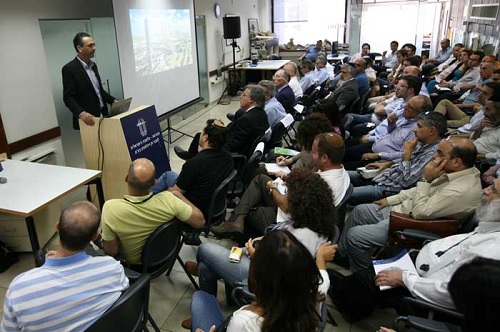Panama Exchange President Akerman Tells Israelis About New Bourse
May 17, 14
 Akerman addressing members of the Israeli diamond and gemstone industry at the |
IDE President Shmuel Schnitzer, IPSDE President Shlomo Eshed and WFDB Honorary President Eli Izhakoff attended the meeting.
Schnitzer said: "The Panama exchange opens up the South America region for us, an area which has not been accessible until now to Israeli diamond companies. The opening in Panama of a diamond exchange creates a legitimate and organized platform for trade with South American countries and there's great potential."
Izhakoff said, "Panama is becoming a major center for diamonds that in the future will be like Dubai. The launch event for the jewelry center that was held in March and which featured all of the global diamond industry leaders made it possible to introduce the ideas behind the exchange which is one of the most exciting things that is going to happen in our industry."
PDE President Ackerman praised the work of Izhakoff on behalf of the Panamanian exchange project. "Without the work of Eli Izhakoff, especially when it comes to involvement with the government, the free trade zone and diamond exchange would never get off the ground. Izhakoff invested a great deal of time in explaining to the president of Panama to explain the nature of the diamond sector and its contribution to Panama's economy."
Ackermann explained to the audience about the complex process that led to the establishment of a diamond exchange in Panama. "Our goal was to convince the government of Panama to open a free trade area specifically for the diamond and colored gemstone industries in Panama City, in one building to be constructed purposely for this purpose.
"The aim was to create an area where you can trade legally and work without intermediaries. Over the years, the IDE helped the government of Panama to understand how a diamond bourse works and how the diamond trade operates.
"Panama's government took a very positive approach and in 2012 requested and received membership in the Kimberley Process. The diamond exchange is determined by law as a full free trade area; there is no tax on trade and there is no corporate tax, either. There is no need for a visa for visitors to Panama, and the government of Panama also offers benefits to members of the exchange concerning immigration to the country. Any company that opens in the bourse in Panama, its personnel can receive permanent residency in Panama and even full citizenship after two years of activity."
Ackerman described the area where the diamond exchange will be located, saying: "The diamond bourse will be in an office tower being developed in a new area in Panama City which is a 10-minute drive from the country's international airport. Until the office building is opened, in October a two-story complex will operate as the diamond exchange until the move. "The building will serve as a diamond exchange in every way, with a trading hall, offices, shops, safes, restaurants and more. The complex will be surrounded by a wall and security provided by Brinks.
"The first floor of the building will be used for jewelry and colored gemstones like jewelry stores but at a wholesale level, while the second floor is designed for use by diamond dealers. Diamond dealers will be able to rent rooms on a regular basis and can also rent rooms by the hour and by the day for trading purposes. Ackerman said, "Diamond companies wanting to enjoy the benefits of the free trade area, should become members of the Panama diamond exchange, incorporate in Panama, and be members of the World Federation of Diamond Bourse (WFDB)."
He added: "Panama enjoys a geographic location, linking North America to South America; it's a small country with four million Spanish-speaking people whose economy is built on free trade. Panama is a stable democracy, with no army and no enemies. In Panama there is already a free trade area, the largest in the world after Hong Kong, which is intended for large commodities and is located 100 kilometers from Panama City."